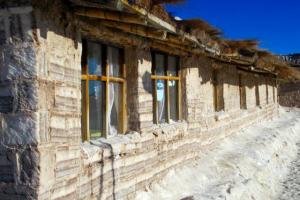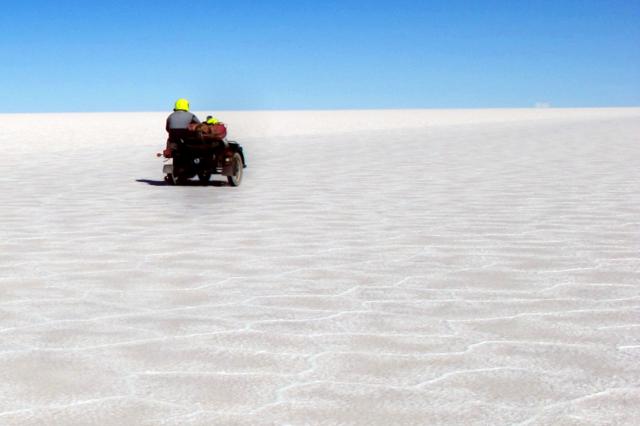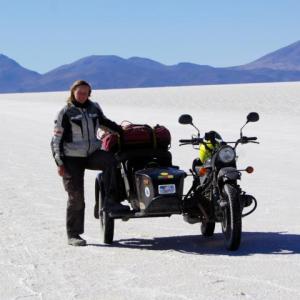I wake in the morning to find a llama and a sheep waiting just outside the tent for me. They accompany me on my trip to the nearby outhouse and then patiently escort me back to the campsite. On our return, we are met by an older lady from one of the nearby homes whom I had tried to chat with before setting up camp the previous evening. She speaks neither English nor Spanish so our communication was limited. Out for a morning walk, she has spotted our tents and bikes and is overwhelmed with curiosity. After a night’s sleep, we are both much more energetic than we were last night and we exchange some animated sign language and huge smiles as I give her a tour of our campsite and demonstrate all of the most interesting features of the bikes. She sits outside Stefan’s tent for about 10 minutes patiently waiting for some sign of life. Finally she gives up and heads to our tent with Miles still slumbering inside. I unzip the fly and give her a peek inside at Miles still tucked in his sleeping bag. She flashes a nearly toothless grin and almost looks like she’s about to climb in and join Miles but instead decides to head back to the other tent where she once again sits patiently waiting for a glimpse inside.
With Stefan still oblivious to any of this activity, our visitor finally decides to end her tour and heads back across the field toward home, followed closely by the llama and the sheep.
It takes a while for the boys to rise. Clearly they need some extra sleep to recover from yesterday’s hard work. When they are finally up, the sun has been out for a while, I’ve returned from a walk in the nearby hills, and we take just enough time for a quick breakfast before once again hitting the trail back to Llica. It’s a beautiful bright day with no signs of yesterday’s bitter wind and on our return trip to Llica we are well-prepared for the roughest parts of the trail and tackle them a bit more easily than we had yesterday. We are better able to enjoy this magical corner of Bolivia – a remote wilderness of harsh hillscapes, psychedelic mineral colours, and tiny quinoa-producing farms.
We arrive in Llica in time for lunch and lounge over bowls of soup. There’s time to spare while everything in town except this soup kitchen is closed for the usual three-hour after-lunch break. We spend some time deciding on our plan for the afternoon. Do we head back to the main highway where we had started several days ago? Or do we take the even more adventurous route across the salt? Easy decision. Salt it is.
After re-fuelling from old soda bottles from someone’s kitchen, exchanging more money and re-stocking our emergency food supplies, we roll through the town’s military base and to the edge of the salt – the Salar de Uyuni to be more precise. This part of the Altiplano has no outlet to the sea and the minerals leached from the surrounding mountains are deposited here, forming a 12,206 km² salt lake, the largest in the world. There are no tracks across the lake, no landmarks, and only one sign pointing vaguely in the direction of where we are headed, the town of Uyuni, almost 300 km away across this expanse of hexagonal white tiles . With no roads and therefore no map or navigation system to rely on, we point our wheels in the direction indicated by the sign and hope for the best.
Miles is a bit bored. Having spent lots of time at the Bonneville Salt Flats in Utah, this is all too familiar for him. But for me, this is a whole new world and I’m loving every minute. At the start, we can see Volcán Tunupa which we passed on the other side a few days ago. It looks far more impressive now, spewing steam into the clear blue sky.
Looking into the distance is eerie. Most of the time, we see nothing but white ground and blue sky. In the few spots where there is water, the surface perfectly reflects the sky and the horizon completely disappears. It feels like we are driving through the sky. Occasionally we pass islands covered in bizarre rock formations and even more bizarre Trichoreus cactus. The whole scene is truly surreal.
As we near the far side of the salt flat, we pass a hotel built almost entirely of salt and then pass through the central area for salt extraction and processing.

There remain at least 10 billion tons of salt in the Salar de Uyuni. Farmers hack it out with picks and shovels and pile it into small conical mounds that line this edge of the lake. The estimated annual output of this operation is nearly 20,000 tons of salt. Most is sold to refiners and hauled off by rail, but some is exchanged with local villages for wool, meat, and grease.
We’ve been driving quickly, carrying enough speed that the hard ridges of salt aren’t too hard on our butts. Miraculously, our dead-reckoning has taken us directly to the town of Colchani, only 20 km north of our destination. But as we head off of the salt and on to the roads, we discover that this will be the longest 20 km that we have travelled. The asphalt on this stretch of road is completely destroyed. Not a single vehicle is driving on the road. They are all maneuvering the rough and winding makeshift tracks in the ditches, dodging one-another at high speed. This is the ultimate contrast to the last several hours of cruising across the salt and a jarring welcome back to the real Bolivian road system.
Tracey










